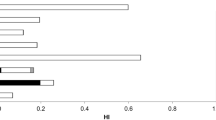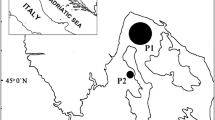Abstract
Background/Objectives:
To assess biomarkers and frequency questions as measures of fish consumption.
Subjects/Methods:
Participants in the Fishermen substudy numbered 125 men and 139 women (aged 22–74), and in the Health 2000 substudy, 577 men and 712 women (aged 45–74) participated. The aim of the Fishermen study was to examine the overall health effect of fish consumption in a high-consumption population, whereas the aim of the Health 2000 substudy was to obtain in-depth information on cardiovascular diseases and diabetes. Fish consumption was measured by the same validated food frequency questionnaire (FFQ) in both the studies, with a further two separate frequency questions used in the Fishermen substudy. Dioxins, polychlorinated biphenyls (PCBs) and methyl mercury (MeHg) (in the Fishermen substudy alone), and omega-3 polyunsaturated fatty acids (omega-3 PUFAs) (in both studies) were analyzed from fasting serum/blood samples.
Results:
The Spearman's correlation coefficients between FFQ fish consumption and dioxins, PCBs, MeHg and omega-3 PUFAs were respectively 0.46, 0.48, 0.43 and 0.38 among the Fishermen substudy men, and 0.28, 0.36, 0.45 and 0.31 among women. Similar correlation coefficients were observed between FFQ fish consumption and serum omega-3 PUFAs in the Health 2000 substudy, and also between FFQ fish consumption and the frequency questions on fish consumption in the Fishermen substudy. According to multiple regression modeling and LMG metrics, the most important fish consumption biomarkers were dioxins and PCBs among the men and MeHg among the women.
Conclusions:
Environmental contaminants seemed to be slightly better fish consumption biomarkers than omega-3 PUFAs in the Baltic Sea area. The separate frequency questions measured fish consumption equally well when compared with the FFQ.
This is a preview of subscription content, access via your institution
Access options
Subscribe to this journal
Receive 12 print issues and online access
$259.00 per year
only $21.58 per issue
Buy this article
- Purchase on Springer Link
- Instant access to full article PDF
Prices may be subject to local taxes which are calculated during checkout
Similar content being viewed by others
References
Andersen LF, Solvoll K, Drevon CA (1996). Very-long-chain n-3 fatty acids as biomarkers for intake of fish and n-3 fatty acid concentrates. Am J Clin Nutr 64, 305–311.
Andersen LF, Solvoll K, Johansson LR, Salminen I, Aro A, Drevon CA (1999). Evaluation of a food frequency questionnaire with weighed records, fatty acids, and alpha-tocopherol in adipose tissue and serum. Am J Epidemiol 150, 75–87.
Arab L (2003). Biomarkers of fat and fatty acid intake. J Nutr 133 (Suppl 3), 925S–932S.
Arisawa K, Matsumura T, Tohyama C, Saito H, Satoh H, Nagai M et al. (2003). Fish intake, plasma omega-3 polyunsaturated fatty acids, and polychlorinated dibenzo-p-dioxins/polychlorinated dibenzo-furans and co-planar polychlorinated biphenyls in the blood of the Japanese population. Int Arch Occup Environ Health 76, 205–215.
Aromaa A, Koskinen S (2004). Health and Functional Capacity in Finland. Baseline Results of the Health 2000 Health Examination Survey. National Public Health Institute: Helsinki.
Asplund L, Svensson BG, Nilsson A, Eriksson U, Jansson B, Jensen S et al. (1994). Polychlorinated biphenyls, 1,1,1-trichloro-2,2-bis(p-chlorophenyl)ethane (p,p′-DDT) and 1,1-dichloro-2,2-bis(p-chlorophenyl)-ethylene (p,p′-DDE) in human plasma related to fish consumption. Arch Environ Health 49, 477–486.
Baxter DC, Rodushkin I, Engstrom E, Klockare D, Waara H (2007). Methylmercury measurement in whole blood by isotope-dilution GC-ICPMS with 2 sample preparation methods. Clin Chem 53, 111–116.
Baylin A, Kim MK, Donovan-Palmer A, Siles X, Dougherty L, Tocco P et al. (2005). Fasting whole blood as a biomarker of essential fatty acid intake in epidemiologic studies: comparison with adipose tissue and plasma. Am J Epidemiol 162, 373–381.
Bergdahl IA, Schutz A, Ahlqwist M, Bengtsson C, Lapidus L, Lissner L et al. (1998). Methylmercury and inorganic mercury in serum—correlation to fish consumption and dental amalgam in a cohort of women born in 1922. Environ Res 77, 20–24.
Björnberg KA, Vahter M, Grawe KP, Berglund M (2005). Methyl mercury exposure in Swedish women with high fish consumption. Sci Total Environ 341, 45–52.
Calder PC, Yaqoob P (2009). Omega-3 polyunsaturated fatty acids and human health outcomes. Biofactors 35, 266–272.
Domingo JL, Bocio A (2007). Levels of PCDD/PCDFs and PCBs in edible marine species and human intake: a literature review. Environ Int 33, 397–405.
EFSA (2004). Opinion of the Scientific Panel on Contaminants in the Food Chain on a request from the commission related to mercury and methylmercury in food. EFSA J 34, 1–14.
Grömping U (2006). Relative importance for linear regression in R: the package relaimpo. J Stat Soft 17.
Hjårtaker A, Lund E, Bjerve KS (1997). Serum phospholipid fatty acid composition and habitual intake of marine foods registered by a semi-quantitative food frequency questionnaire. Eur J Clin Nutr 51, 736–742.
Hodson L, Skeaff CM, Fielding BA (2008). Fatty acid composition of adipose tissue and blood in humans and its use as a biomarker of dietary intake. Prog Lipid Res 47, 348–380.
Hunter DJ (1998). Biochemical indicators of dietary intake. In: Willett W (ed). Nutritional Epidemiology. Oxford University Press: New York. pp 174–243.
Isosaari P, Hallikainen A, Kiviranta H, Vuorinen PJ, Parmanne R, Koistinen J et al. (2006). Polychlorinated dibenzo-p-dioxins, dibenzofurans, biphenyls, naphthalenes and polybrominated diphenyl ethers in the edible fish caught from the Baltic Sea and lakes in Finland. Environ Pollut 141, 213–225.
Jenab M, Slimani N, Bictash M, Ferrari P, Bingham SA (2009). Biomarkers in nutritional epidemiology: applications, needs and new horizons. Hum Genet 125, 507–525.
Jula A, Marniemi J, Ronnemaa T, Virtanen A, Huupponen R (2005). Effects of diet and simvastatin on fatty acid composition in hypercholesterolemic men: a randomized controlled trial. Arterioscler Thromb Vasc Biol 25, 1952–1959.
Kiviranta H, Ovaskainen ML, Vartiainen T (2004). Market basket study on dietary intake of PCDD/Fs, PCBs, and PBDEs in Finland. Environ Int 30, 923–932.
Kiviranta H, Vartiainen T, Parmanne R, Hallikainen A, Koistinen J (2003). PCDD/Fs and PCBs in Baltic herring during the 1990s. Chemosphere 50, 1201–1216.
Kiviranta H, Vartiainen T, Tuomisto J (2002). Polychlorinated dibenzo-p-dioxins, dibenzofurans, and biphenyls in fishermen in Finland. Environ Health Perspect 110, 355–361.
Kobayashi M, Sasaki S, Kawabata T, Hasegawa K, Tsugane S (2003). Validity of a self-administered food frequency questionnaire used in the 5-year follow-up survey of the JPHC Study Cohort I to assess fatty acid intake: comparison with dietary records and serum phospholipid level. J Epidemiol 13, S64–S81.
Kruskal W (1987). Relative importance by averaging over orderings. Am Stat 41, 6–10.
Li D, Zhang H, Hsu-Hage BH, Wahlqvist ML, Sinclair AJ (2001). The influence of fish, meat and polyunsaturated fat intakes on platelet phospholipid polyunsaturated fatty acids in male Melbourne Chinese and Caucasian. Eur J Clin Nutr 55, 1036–1042.
Lindeman RH, Merenda PF, Gold RZ (1980). Introduction to Bivariate and Multivariate Analysis. Longman Higher Education: Glenview, IL.
Ma J, Folsom AR, Shahar E, Eckfeldt JH (1995). Plasma fatty acid composition as an indicator of habitual dietary fat intake in middle-aged adults. The Atherosclerosis Risk in Communities (ARIC) Study Investigators. Am J Clin Nutr 62, 564–571.
Masson LF, McNeill G, Tomany JO, Simpson JA, Peace HS, Wei L et al. (2003). Statistical approaches for assessing the relative validity of a food-frequency questionnaire: use of correlation coefficients and the kappa statistic. Public Health Nutr 6, 313–321.
Mina K, Fritschi L, Knuiman M (2007). A valid semiquantitative food frequency questionnaire to measure fish consumption. Eur J Clin Nutr 61, 1023–1031.
Mozaffarian D (2008). Fish and n-3 fatty acids for the prevention of fatal coronary heart disease and sudden cardiac death. Am J Clin Nutr 87, 1991S–1996S.
Männistö S, Virtanen M, Mikkonen T, Pietinen P (1996). Reproducibility and validity of a food frequency questionnaire in a case–control study on breast cancer. J Clin Epidemiol 49, 401–409.
National Public Health Institute (2008). Fineli Finnish Food Composition Database. http://www.fineli.fi/3.9.2008.
Paalanen L, Männistö S, Virtanen MJ, Knekt P, Räsänen L, Montonen J et al. (2006). Validity of a food frequency questionnaire varied by age and body mass index. J Clin Epidemiol 59, 994–1001.
Philibert A, Vanier C, Abdelouahab N, Chan HM, Mergler D (2006). Fish intake and serum fatty acid profiles from freshwater fish. Am J Clin Nutr 84, 1299–1307.
R Development Core Team (2009). R: A Language and Environment for Statistical Computing. R Foundation for Statistical Computing, Vienna, Austria. ISBN 3-900051-07-0, URL http://www.R-project.org.
Sun Q, Ma J, Campos H, Hankinson SE, Hu FB (2007). Comparison between plasma and erythrocyte fatty acid content as biomarkers of fatty acid intake in US women. Am J Clin Nutr 86, 74–81.
Svensson BG, Nilsson A, Hansson M, Rappe C, Akesson B, Skerfving S (1991). Exposure to dioxins and dibenzofurans through the consumption of fish. N Engl J Med 324, 8–12.
Svensson BG, Nilsson A, Jonsson E, Schutz A, Akesson B, Hagmar L (1995). Fish consumption and exposure to persistent organochlorine compounds, mercury, selenium and methylamines among Swedish fishermen. Scand J Work Environ Health 21, 96–105.
Tuomisto J, Vartiainen T, Tuomisto J (1999). Synopsis on Dioxins and PCBs. National Public Health Institute: Kuopio.
Turunen AW, Verkasalo PK, Kiviranta H, Pukkala E, Jula A, Mannisto S et al. (2008). Mortality in a cohort with high fish consumption. Int J Epidemiol 37, 1008–1017.
Van den Berg M, Birnbaum L, Bosveld AT, Brunstrom B, Cook P, Feeley M et al. (1998). Toxic equivalency factors (TEFs) for PCBs, PCDDs, PCDFs for humans and wildlife. Environ Health Perspect 106, 775–792.
Welch AA, Bingham SA, Ive J, Friesen MD, Wareham NJ, Riboli E et al. (2006). Dietary fish intake and plasma phospholipid n-3 polyunsaturated fatty acid concentrations in men and women in the European Prospective Investigation into Cancer-Norfolk United Kingdom cohort. Am J Clin Nutr 84, 1330–1339.
Willett WC (1998). Food-frequency methods. In: Willett W (ed). Nutritional Epidemiology. Oxford University Press: New York. pp 74–100.
Woods RK, Stoney RM, Ireland PD, Bailey MJ, Raven JM, Thien FC et al. (2002). A valid food frequency questionnaire for measuring dietary fish intake. Asia Pac J Clin Nutr 11, 56–61.
Yang L, Colombini V, Maxwell P, Mester Z, Sturgeon RE (2003). Application of isotope dilution to the determination of methylmercury in fish tissue by solid-phase microextraction gas chromatography–mass spectrometry. J Chromatogr A 1011, 135–142.
Acknowledgements
We thank the volunteers and the research staff of the Fishermen study and the Health 2000 health examination survey. This work was supported by the Academy of Finland (project numbers 77008, 205324, 206950, 124286); the Finnish Cancer Organisations; the Yrjö Jahnsson Foundation and the Juho Vainio Foundation.
Author information
Authors and Affiliations
Corresponding author
Rights and permissions
About this article
Cite this article
Turunen, A., Männistö, S., Kiviranta, H. et al. Dioxins, polychlorinated biphenyls, methyl mercury and omega-3 polyunsaturated fatty acids as biomarkers of fish consumption. Eur J Clin Nutr 64, 313–323 (2010). https://doi.org/10.1038/ejcn.2009.147
Received:
Revised:
Accepted:
Published:
Issue Date:
DOI: https://doi.org/10.1038/ejcn.2009.147
Keywords
This article is cited by
-
Dietary habits and plasma lipid concentrations in a general Japanese population
Metabolomics (2024)
-
Biomarkers of meat and seafood intake: an extensive literature review
Genes & Nutrition (2019)
-
Plasma concentrations of anserine, carnosine and pi-methylhistidine as biomarkers of habitual meat consumption
European Journal of Clinical Nutrition (2019)
-
Dietary supplementation with Lovaza and krill oil shortens the life span of long-lived F1 mice
AGE (2014)
-
Environmental contaminants as biomarkers of fish intake: a case for hair mercury concentrations
European Journal of Clinical Nutrition (2011)



